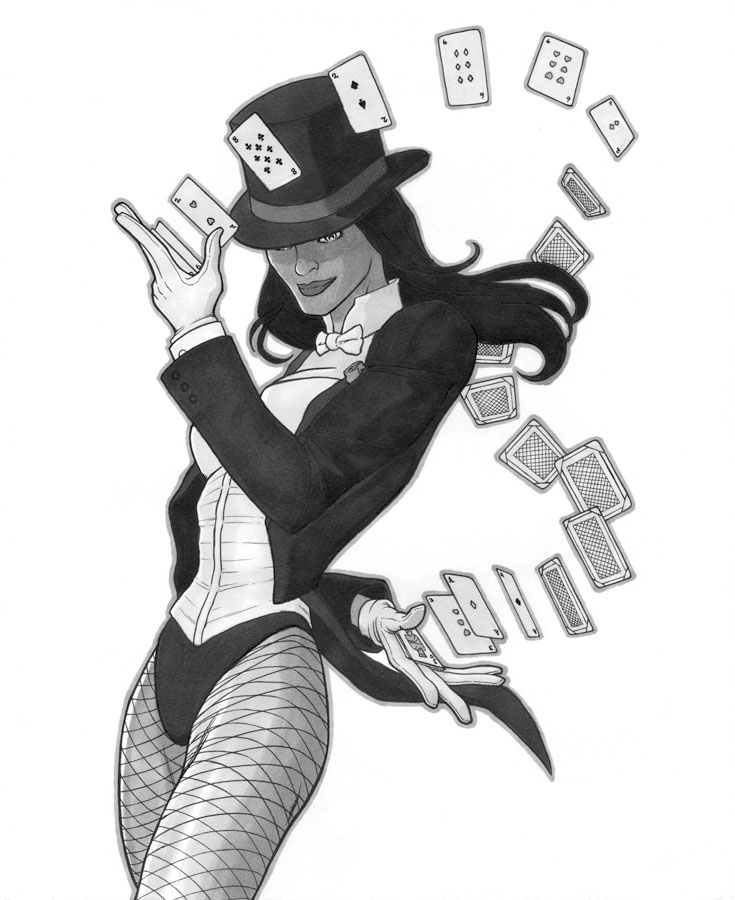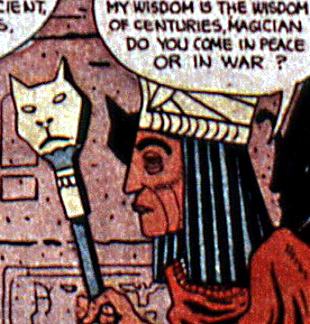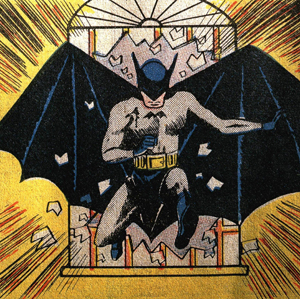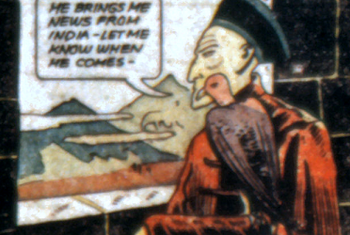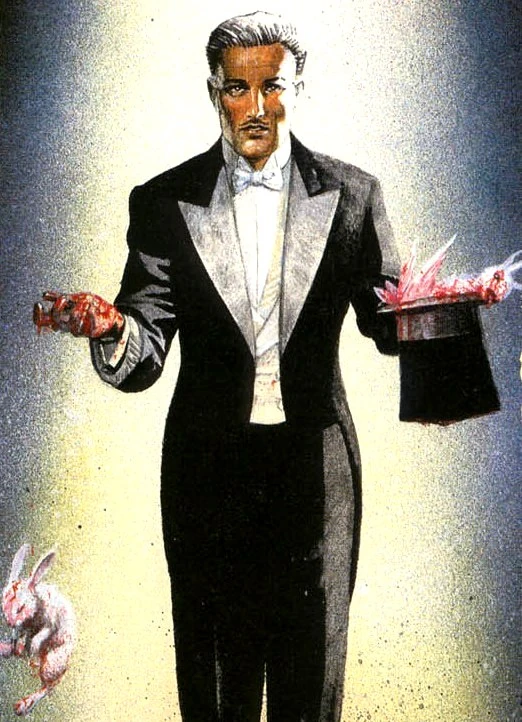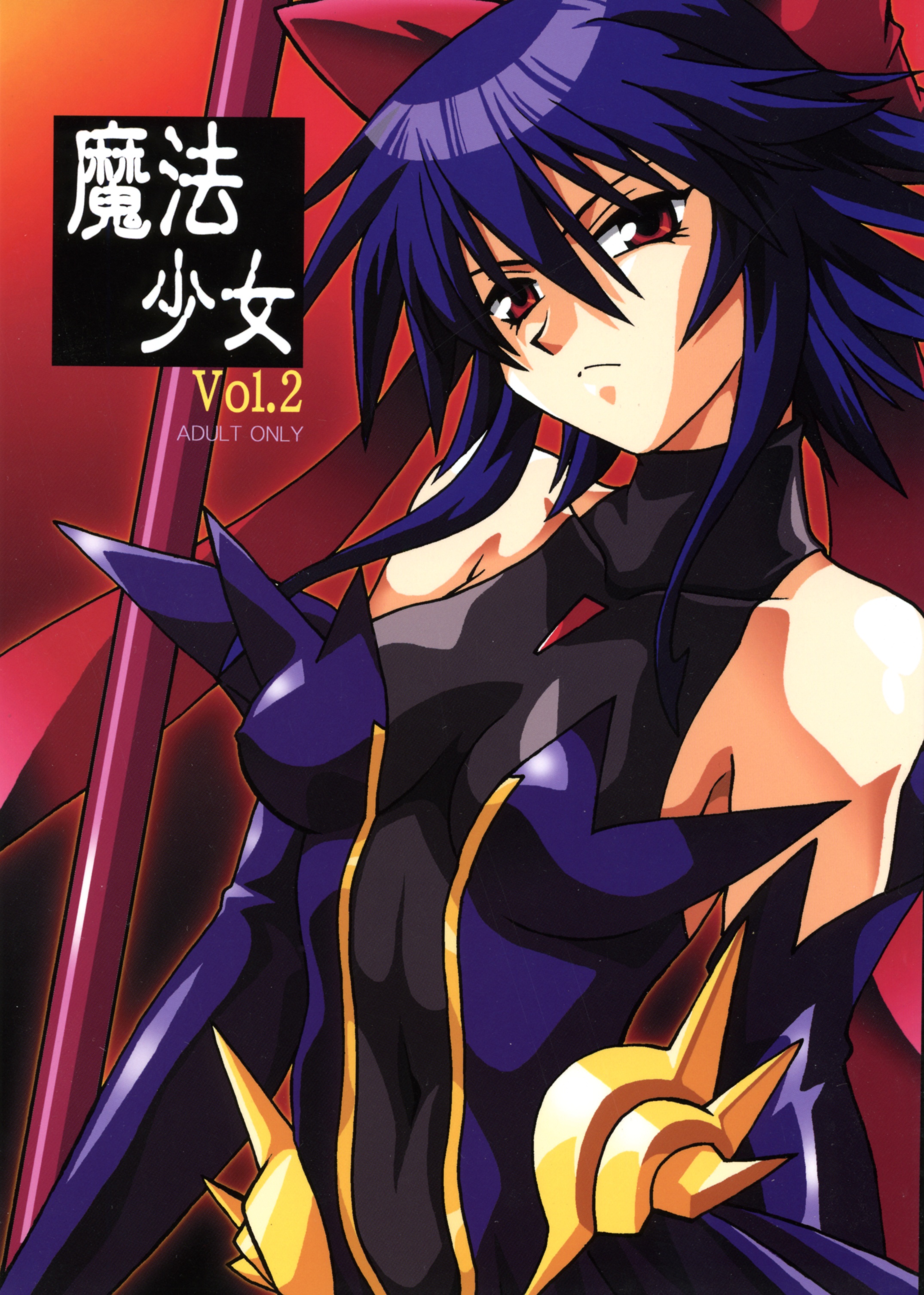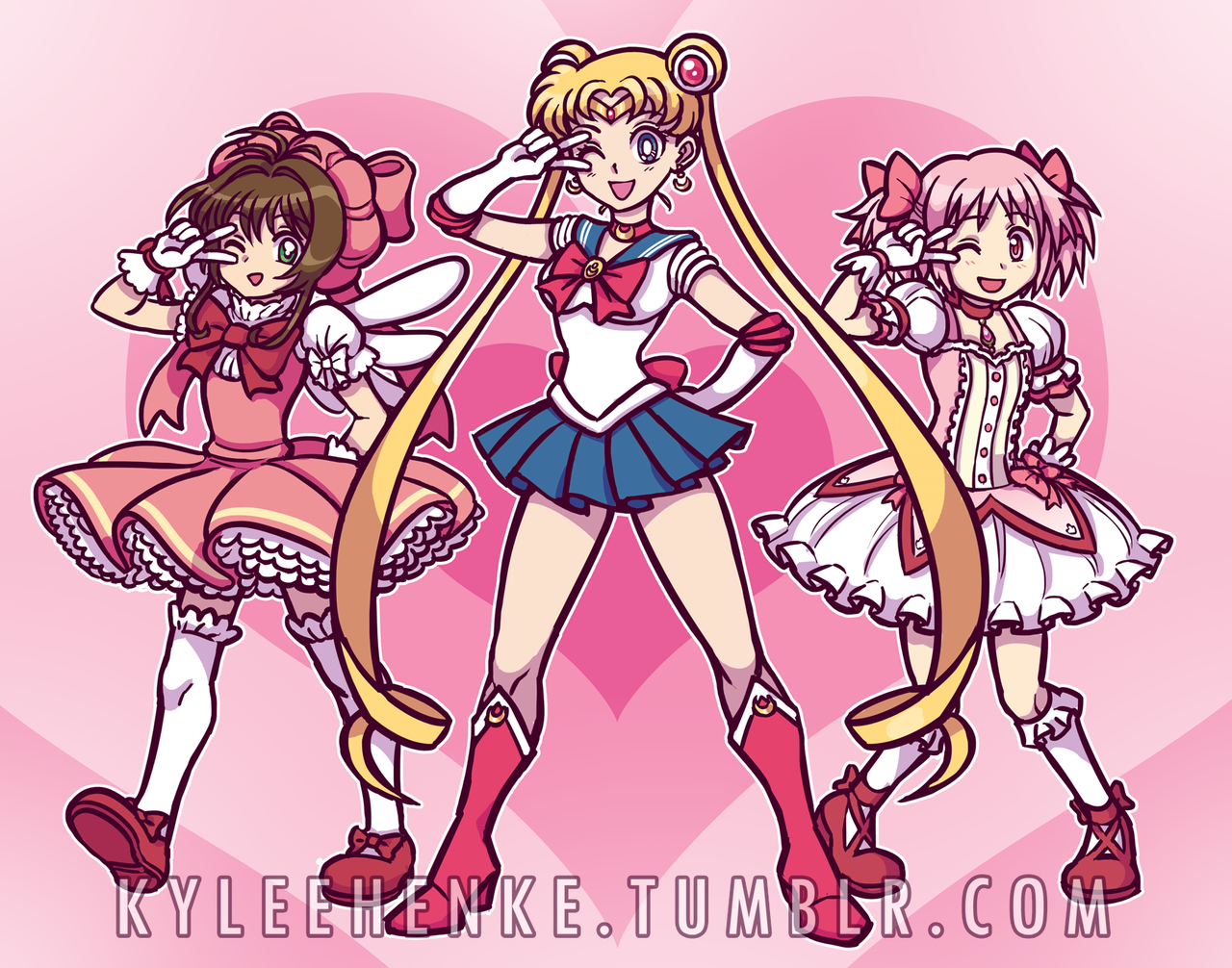
Ladies and Gentlemen, prepare yourself for a show like no other. What do you hear when I say "magic"? A trick of the light? A quick hand movement? Smoke and mirrors? Perhaps magic is but smoke...but perhaps the universe itself is but smoke. Prepare to have you sense of reality challenged, to be shown a world beyond ours, where impossibility serves only as an invitation. Allow me to introduce our star...The Magic Maid Zatanna Zatara!

Origins:
Young 15-year old Zatanna was the daughter of the great Stage Magician Giovanni Zatara and was determined to live up to the family name. They would regularly tour together and Zatanna eagerly took up instruction from her father. Then one day she came home to find her father missing. Looking through her father's books Zatanna discovered to her amazement that her lost mother was actually one of the homo magi, a sub-species of humans who had founded Atlantis and were gifted with the ability to naturally perform magic. She found further that her father was no plain street magician but was in fact a real magician and used to be a superhero. Determined to find her father, Zatanna began researching through her father's spellbooks, learning the art of magic. The events are chronicled here.
She would search aimlessly for 20 years for him across the worlds and dimensions until with the Justice League of America's help she was finally reunited. Zatanna then joined the Justice League as their official magician, and was instrumental to fighting for the cause of Justice across the worlds.
Zatanna's magic is essentially the power of suggestion, willing yourself or others to enter into a different reality. Zatanna is so adept at the power of magic she can suspend the laws of nature with just a few backwards words. Zatanna rarely uses her power to the fullest, because it is difficult to retain one's connection to normalcy when one can change reality at will. Indeed when a normal human is given access to Zatanna's power, it causes him to go insane. Despite this, Zatanna is incredibly powerful even for a magic-user. The first rule of magic is that man is as strong as he allows himself to be but Zatanna seems very at ease with usage of magic and being far beyond the limits of humanity. This is likely due to the heavy magic used in her conception. When Zatanna was born, Zatara imbued in her his four spellbooks, the 4 elements, giving her all the greatest qualities of humanity to the extent he could. She was his greatest spell, a magician with a kind heart, graceful body, keen mind, and strong spirit. These are the tools with which she casts her magic.
This blog treats all Zatanna comics as canonical, because they are. Not only did DC Rebirth make them all canon, but the Magicians have never been bound by canonicity due to their ability to choose realities at will. As an example, Zatara in the Silver Age conjured up his first enemy from the beginning of the Golden Age and spoke of their previous encounter.
Physical Strength/Skill:
While she is primarily a magic-based fighter, Zatanna can engage in a little fisticuffs from time to time. She has knocked out Felix Faust, a powerful magic-user with a punch and she has out-meleed supernatural hunters.
She is adept at melee because as a girl Zatara made her take martial arts classes for her own protection. Specifically, she knows judo and is adept at throws. She's also a red belt at Martian Kung Fu.
Physical Durability:
Even unshielded, Zatanna regularly has durability far beyond the normal human. She has been shot in the neck and recovered conscious in minutes at most, survived consuming fire and having her lungs literally on fire and survived a magical blast from Cain, the first vampire.
Even more impressive, she has survived the super-breath of Pre-Crisis Supergirl. Given Pre-Crisis Kryptonians could freeze or push stars with their super-breath this is quite the achievement. She has also twice survived taking hits from New 52 Wonder Woman, once brainwashed (1) (2). The same Wonder Woman could stagger Apollo, literally the Sun, with her strikes. She has also survived a hole in spacetime.
Mundane Skills:
Zatanna is skilled in several mundane skills, including stage magic. Such things sometimes allow her to gain an advantage against her enemies who aren't used to such material means of deception.
Of the stage magic tricks, Zatanna is particularly good at sleight of hand. She is also highly trained in escape artistry, having learned how to get out of a straightjacket underwater in Kindergarten.
Magical Equipment:
A Magician is handicapped without her useful tools. Among her most-used magical equipment, Zatanna can summon a crystal ball to give her answers to her problems. This Crystal Ball can also tell her the future. She also possesses a flying carpet to take her where she wants to go in style. She also tends to carry a wand, although this seems purely for show.
Genie:
Zatara's most faithful companions is her genie assistant capable of binding most metahuman enemies she runs across. The genie can also transform into what she wants it too.
Shadowcrest:
Shadowcrest is Zatanna's magical home, which she can teleport herself and others to at any time to get a homefield advantage. It functions as her batcave, with magical books and artifacts. The house is bigger on the inside then it is on the outside. One of the rooms in Shadowcrest contains a whole galaxy and yet others contain monsters too powerful for Mary Marvel with Black Adam's powers to fight. But the most dangerous thing in Shadowcrest is also one of the strongest trump cards in the DCU: The Gnosis Sphere
It is the duty of the Zatara bloodline to protect the Gnosis Sphere, a sphere capable of answering any question, even things man was not meant to know. Those who use it are at high risk of going insane.
Also if someone in Shadowcrest is misbehaving, Zatanna can banish that person from Shadowcrest and make it lost to them forever.
The Basics of Magic:
Just to explain some of the basics of Zatanna's magic first. Zatanna does not actually need to speak backwards to cast magic. Here she is putting The Top to sleep without speaking. Speaking backwards just sharpens the concentration and makes it easier. Her writing can also be used for this purpose.
At any given time, Zatanna has HUNDREDS of spells prepared, even ignoring her amazing improvisation skills. Originally Zatanna could only use White Magic and so was vulnerable to Black Magic, although after learning Black Magic, she no longer has this vulnerability.
Elemental Magic:
For a time, Zatanna was limited to merely the manipulation of the 4 elementals imbued inside her. As such, her manipulation of these 4 forces is particularly close. She can call the winds between the worlds to carry her away from danger or create a wind cage around a demon. Her fire magic is strong enough to throw Pre-Crisis Supergirl although this is likely at least in part due to her magic vulnerability, though her fire has also burned Swamp Thing before. She can also turn blood to fire.
Also while not strictly the normal 4 elements she has frozen both The Top and a fire-based supervillain before. Zatanna has also twice shot magic lightning from her fingertips (1) (2)
Eventually this restriction would be lifted and Zatanna gained the ability to affect all cosmic forces.
Speed/Flight:
Zatanna is quite quick, only amplified by her ability to magically fly.
She is able to avoid gunfire and has raised her hands and spoke in the time it took bullets to reach from from a close range. This would imply she is in the hypersonic range, which is consistent both with the fact that she flew at seemingly the same speed as Hawkman and Red Tornado and flew from the United States to the Himalayas in a short amount of time.
Even faster then this, Zatanna has seemingly flown at the same speed as Pre-Crisis Supergirl. However it is unlikely Supergirl was going full-out given Kryptonians regularly hold back the abilities. Still Kryptonians like Pre-Crisis Superboy have casually broken the time barrier many times...Zatanna is also able to react to people like Lobo in motion

Spacetime Magic:
When she really needs to get around, Zatanna can play around with the passage of spacetime.
Zatanna can easily teleport a group up to the Hall of Justice. To even begin to challenge her, you would require transport across dimensions. Here we see her travel between dimensions casually. Zatanna can enter magical realms where no human could exist. It is the specific talent of the Magicians to jump between realities. Zatanna can also enter the neutral area between realities and has teleported the JLA to the mystical realm of the god Anansi, likely in the Sphere of the Gods.
Zatanna can control time as easily. As a teenager, she was able to slow the flow of time. She can if wanted peel back the layers of time and spirit or conversely repair holes in the timestream. She can go back in time or send other people back, even to the beginning of time. She can even cause time go backwards. Even greater, she, Madame Xanadu, and Nightmare Nurse froze time across the entire multiverse, suggesting she along should have at least universal time stop.
Besides these tricks she was also able to threaten a Freddy Kruegar knock-off with being sent back into every nightmare they've ever been in, splitting them apart entirely. Because of her control of spacetime, it is very difficult to evade her as she can create portals to follow specific people and has chased the magic thief Uriah across universes and dimensions, time and space.
Sealing:
Zatanna can seal enemies away in physical objects like when she sealed Allura, her father's most dangerous enemy, into a bottle. She can also seal enemies in her hat
Duplication:
Zatanna can create illusory copies of herself to help her do battle
Shield:

Zatanna can create a magical shield to protect her or the JLA. This shield is strong enough to protect against Lobo or even the ghost of her father. This shield can reflect attacks, including the power of Black Adam being used by Mary Marvel. The shield can grow large enough to protect entire buildings.
Healing Magic:
Zatanna can heal people. Here she heals Batwoman. She can conjure healing potions potent enough to revive someone from being comatose. Her magic has also kept a group of infants alive despite the Invading Martians psychic attack weakening the magic of the Earth.

Transmutation:
The big one. Zatanna does this A LOT, so just gonna list best examples. She is particularly fond of turning enemies into toads. She has also turned an enemy into a fluffy bunny. She has turned an audience into vampire bats to help Batman fight the Joker and changed poison gas to oxygen.
Mere child's play. Zatanna has turned a monster in 12 harmless baby versions of the monster. She can turn people inside out. When angry she can burn the flesh from someone's bones, turn them to stone, or make them vanish altogether. She has even turned the "light of death" into harmless flowers.
Still not impressed? What about larger then a mere human. She has turned oceans of lava into fields of daisy. When brainwashed she covered the moon in an ocean and made the Earth fly. She has even made a dress with supposedly "real stars" for herself.
Or perhaps you would prefer REAL small. Zatanna has proven capable of affecting even atoms, such as removing the Red Sun radiation from Superman.
Animation:
Zatanna can animate inanimate objects to fight for her.
Summoning:
Zatanna never fights alone! Summoning servants is a very basic magic.
The forces of darkness are bound to Zatanna's will. She can summon demons, even a fire demon strong enough to fight Pre-Crisis Superman. She can summon the Hellish Nightmare Nurse, a powerful magic user in her own right. And her magic can even awaken the Old Gods.
More benevolently, her magic can summon other Justice League Members.
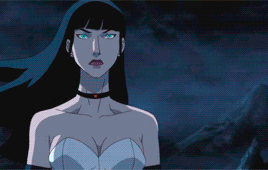
Destruction Magic:
The Mistress of Magic can be most scary when angered into destroying. Her magic is powerful enough to shake a building around her merely as a side-effect of her casting. She has forced a robot to explode and when Lobo made her lose her father again, she caused him to bleed and flayed the skin from his body. She can create a year's worth of sunlight in a second and is implied to be able to sink Atlantis.
And this is only the beginning. Zatanna managed to briefly put down Starbreaker, a Universal Threat who previously soloed the JLA. She has broken a magical barrier that Nightmare Nurse and Phantom Stranger couldn't. She has cast a spell powerful to tear down the very walls of reality, which created a huge explosion purely as a side-effect. In her rage, she can destroy the whole universe.
Soul Magic:
Zatanna can project her conscious onto the astral plane. She can still act with it out, and it can carry physical objects or enter into others' dreams.
Zatanna can also free a soul, or with more difficulty transfer a soul to a different body. And she can consign a soul to the Abyss causing it's permanent end.
Mind Magic:
Zatanna's magic gives her passive telepathy allowing her to sense anger, trouble, mystical influences or mystical vibrations. She can also telepathically contact other.
Beyond this, she has telekinetic and psychokinetic powers. Enough to throw the Martian Manhunter. Zatanna can make people lose memories. She can change someone's personality, such as turning Doctor Light the sadistic psycho-rapist into a bumbling moron. She has even wiped her childhood friend Batman's memory and action which so haunted her, she calls it "the worst mistake I ever made".
Beyond this, Zatanna has freed the whole league from Despero's influence and trapped Joker in a perpetual nightmare. She can draw others into her mind and can cause a mental plane being to be forgotten forever.
Spirit Magic:
When dealing with evil spirits, Zatanna can dispel the spirit or trap it in a cage of it's own rage and spite. When dealing with more helpful spirits, Zatanna can call down benevolent spirits to help people or restore spiritual being.
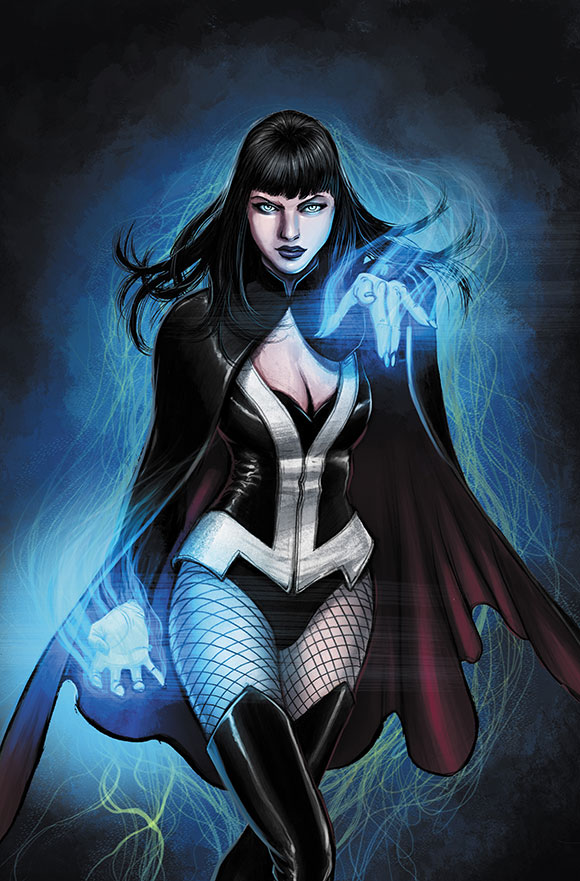
Invisibility/Intangibility:
Zatara has turned herself and the league invisible before. She also has turned intangible.
Size-Manipulation:
Zatanna can grow to a much larger size to gain an advantage in combat. Like that time she grew to the size of a dimension.
Though that is a bit...ambigious. Her best size manipulation feat is her battle with Zor. In this fight Zatanna and Zor's body, much like Zatanna's old father Zatara, grew to the size of large planets. In this form Zatanna was tough enough to be thrown hard enough to break reality and was powerful enough to destroy Zor, who had become a living universe.
Zatanna, should it prove helpful, can also shrink down as well.
Reality-Warping:

Arguably what all of Zatanna's abilities are, Zatanna can do such trivial tricks as suspending gravity and turning night to day. She can change someone's gender and history for a bit of fun and it is directly said that her and Constantine magic can warp the universe.
Existence Erasure:
Should things need to stop being, Zatanna can make them vanish outright or if she wants take them to the area between planes which will cause them to cease to be.
Power Manipulation:
Zatanna can alter the powers of other people if she prefers them to not have the powers they have. She can transfer powers from one person to another and can give herself the powers and personality of other people if she wants to be like them.
Silence:
Zatanna can magically impose silence on others which can be helpful if her opponent is a mage who needs to speak
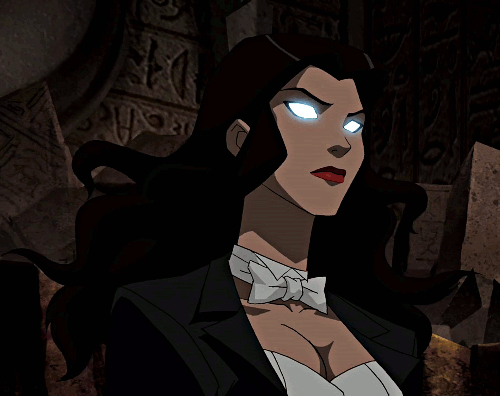
Metamagic:
Zatara can remove a curse or cause a spell to cease with just as much ease as any other spell. Her metamagic is so good she can counter the magic of Black Lantern Zatara, she can control other sorcerers' magic, and when Superman temporarily had Zatanna's magic though was extremely unskilled with it, he was able to return all the magic of the magic dimension back to it.
She also gave Batman a charm to dispel all magic even to the level of Circe for a brief time. She has also taught Superman how to fight against magical foes.
Magical Potential:
Zatanna's potential as a magic-user eclipses her father. She rarely uses even a fraction of her full power to preserve her normality. Truthfully, with her internal magic reserve, Zatanna is the most powerful member of the Justice League. She is one of the most powerful sorcerers in all dimensions and the Quintessance, the group of 5 cosmic beings that oversee the multiverse, count her as a powerful future ally. She along with the other Sorcerers of Earth were able to give The Spectre enough power to battle the Anti-Monitor evenly, while Anti-Monitor was becoming one of the Presence's aspects, their battle being powerful enough to shatter all of creation and reboot the Pre-Crisis Canon to Post-Crisis Canon. Even an infinitesimal part of that would be far multiversal.
But not even this compares to her greatest feat...
Ladies and Gentleman, you have seen Zatanna perform many mind-bending feats so far, but this next one will shake you to your soul, please hold on, and if you have a history of heart conditions you may wish to stop reading right now. The rest, prepare to be taken to the ultimate, the absolute, the world beyond all worlds.
At one point, Zatanna and her father were called as a group of the strongest magic-users to oversee the battle of the forces of Heaven and Hell against a being that made Anti-Monitor seem minor. The Great Evil Beast, the Anti-Presence, the infinite darkness that seeks to consume ALL. It was too much for the poor magic-users, and to protect his daughter, Zatara took the whole of the Great Evil Beast inside him and managed to survive very briefly.
Much later Zatanna would encounter Pralaya, the feminine form of The Great Evil Beast. She is the darkness that is the unconscious of God, Brahman's sleep, the end of all things physical and metaphysical. She pervaded existence and tore it and destroy it leaving nothing...
or so she thought!
From deep within Pralaya, non-existence itself, Zatanna maintained the mental projections of herself and Constantine. They quickly created a new Swamp Thing before Pralaya found them. Zatanna's power was able to hold off even Pralaya, non-existence in it's entirety briefly allowing Swamp Thing to tap into the World Tree inside Pralaya and reset all of creation.
And that was how our dear Magic Maid saved all of creation.
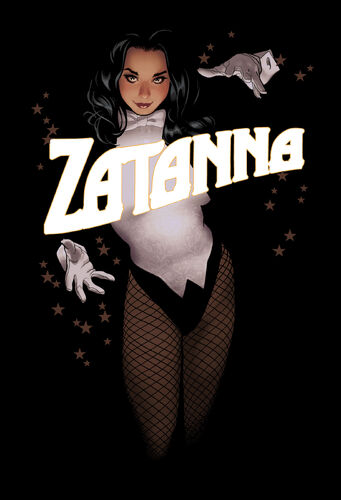
Feats:
- Used Palindrome to defeat a time manipulator who reversed her actions so the magic would still work
- Took the ring off John Stewart's finger
- Through sheer willpower, regains conscious as a puppet
- Escapes the Beginning of Time which shows your desires as reality through willpower
- John Constantine, her ex-boyfriend, had to resort to begging for her help
- In her first magic battle, tricked Zatara's strongest enemy
- Lead the Justice League Dark
- Is the Justice League of America's official Magician
- Has Several times overcome her father when he was brainwashed or otherwise not himself
- Defeated Zor a magic user who had become a whole universe
- Led the Magic Team that reconstructed the rock of eternity, issuing in the 10th Age of Magic
- The Spectre has given praise to Zatanna's soul as pure
- Fought along with the other Sorcerers of Earth to aid the Spectre against the Anti-Monitor
- Stopped Pralaya, briefly holding off her raw power, and outwitting her leading to the reconstruction of the whole of creation

Weaknesses:
Big one first, if she is stopped from speaking her ability to cast spells is greatly limited. She can get around it to some extent, but it is difficult. She also rarely uses her full power because of it's dangerous instability and capacity to break apart everything she knows and loves about the universe.
Due to the sheer power of her magic, she has to be very careful with it. If she pushes herself too hard, the magic will fail, and she might even tear herself apart. And for all her magical power she can't revive the dead.
She's also a spellaholic

Zatanna is a complete daddy's girl. She loves her father and everything he stood for. Her dream is to live up to him and to make him proud.
Besides this Zatanna is a mischievous but noble person who blends the light and dark as any magician must. She is naughty enough to use her power for...rather impure reasons but her heart is noble enough that The Spectre itself is forced to admit it. While she is prone to sarcasm and light-heartedness like making her ringtone "every little thing she does is magic" yet is also a true friend to misfits (and rabbits) and was courageous enough to charge Amazo without her powers.
The line of Magicians of which Zatanna is emblematic of is representative the darker back of DC Comics, the smokey and shadowy area of causation and secrets of why things are. When the hero beats the villain, always behind the scenes are demons trying to tempt the hero to fail and some mystic or magician to drive them away. Zatanna in all her mysterious aloofness yet deepfelt emotion is that dark ocean, concealing a secret power beyond all normal conception of how power should be.
Good night ladies and gentlemen.

Summary:
Between Tiers 10 and 5 normally, Tier 1 at max
Between Planet and Universe Level DC in most realities, Omniversal at highest
At Least Building Level Durability, possibly Star Level, Galaxy Level with Shield, Universe Level in some realities
At least Hypersonic Speed, Possibly MFTL, MFTL Reflexes/Attack Speed
Skilled Fighter
Superhuman Physical Strength
Skilled at Stage Magic
Magical Artifacts
Summoning
Control of the Elements
Flight
Inter-Dimensional Travel
Spacetime Control
Sealing
Duplication
Illusions
Magical Shield
Attack Reflection
Healing
Transmutation
Animation
Energy Manipulation
Can affect the Astral, Mental, and Spirtual Planes
Invisibility
Intangibility
Size Manipulation
Dimension Manipulation
Reality-Warping
Existence Erasure
Power Manipulation
Can Impose Silence
Metamagic
-Can't use full power very efficiently
-Needs to be in certain realities to use certain level of power
-Needs to speak to use powers very efficiently
-Can't resurrect
Possible Opponent:
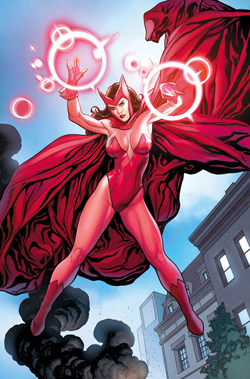
Zatanna vs Scarlet Witch:
Apparently these two are DC and Marvel equivalents of each other. Can't comment on the fight other then that since I don't really know Marvel.
Next Time:
